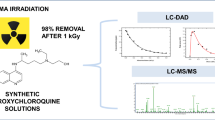Summary and Conclusions
The degradation of RH1 in aqueous solution is found to be both acid and base catalyzed. The maximum stability is obtained in neutral pH but still degrades by 10% (t90) after just 1 week. The stability profile at pH 5 was done, and 4 major degradation products were observed in acid solutions. LC-MS was performed and the molecular weights determined, from which a degradation mechanism was proposed. Degradation products I, II, and III form 2 isomers each depending on which aziridine group is hydrolyzed. No significant effect of light or the presence of antioxidants was observed, indicating that photodegradation and oxidation are not likely degradation reactions.
Similar content being viewed by others
References
Brown JM, Giaccia AJ. The unique physiology of solid tumors: opportunities (and problems) for cancer therapy.Cancer Res.1998;58:1408–1416.
Ernster L. DT-diaphorase: a historical review.Chem Scr. 1987;27A:1–13.
Winski SL, Hargreaves RH, Butler J, Ross D. A new screening system for NAD(P)H: quinone oxidoreductase (NQO1)-directed antitumor quinones: identification of a new aziridinylbenzoquinone, RH1, as a NQO1-directed anti-tumor agent EO9.Clin Cancer Res. 1998;4:3083–3088.
Cheung AP, Struble E, Nguyen N, Liu P. Stability-indicating HPLC assay and solution stability of a new diaziridinyl benzoquinone.J Pharm Biomed Anal. 2001;24:957–966.
Kusai A, Tanake S, Ueda S. The stability of carboquone in aqueous solution. 1. Kinetics and mechanism of degradation of 2,5-diethylenimino-1, 4-benzoquinone in aqueous solution.Chem Pharm Bull (Tokyo) 1981;29:3671–3679.
Kusai A, Tanake S, Ueda S. The stability of carboquone in aqueous solution. II. Kinetics and mechanism of degradation of 2,5-bis-(1-aziridinyl)-3,6-dimethyl-1,4-benzoquinone and 2,5-bis-(1-aziridinyl)-3,6-diisopropyl-1,4-benzoquinone in aqueous solution.Chem Pharm Bull (Tokyo). 1982;30:2534–2543.
Kusai A, Ueda S. The stability of carboquone in aqueous solution. III. Kinetics and mechanism of degradation of carboquone in aqueous solution.Chem Pharm Bull (Tokyo). 1984;32:2406–2413.
Kusai A, Tanake S, Ueda S. The stability of carboquone in alcohols. I. Kinetics and mechanism of degradation of 2,5-bis(1-aziridnyl)-1, 4-benzoquinone in alcohols.Chem Pharm Bull (Tokyo). 1985;33:2983–2989.
Kusai A, Ueda S. The stability of carboquone in alcohols. II. Kinetics and mechanism of carboquone in methanol.Chem Pharm Bull (Tokyo). 1985;34:1299–1308.
Poochikian GK, Cradock JC. 2,5-Diaziridinyl-3,6-bis(carboethoxyamino)-1,4-benzoquinone. I. Kinetics in aqueous solutions by high performance liquid chromatography.J Pharm Sci. 1981;70:159–162.
Poochikian GK, Kelley JA. 2,5-Diaziridinyl-3,6-bis(carboethoxyamino)-1,4-benzoquinone. II. isolation and characterization of degradation products.J Pharm Sci. 1981;70:162–167.
Author information
Authors and Affiliations
Corresponding author
Additional information
Published: March 2, 2007
Rights and permissions
About this article
Cite this article
Jain, N., Machatha, S.G., Tabibi, S.E. et al. Degradation kinetics and mechanism of RH1, a new anti-tumor agent: A technical note. AAPS PharmSciTech 8, 16 (2007). https://doi.org/10.1208/pt0801016
Received:
Accepted:
DOI: https://doi.org/10.1208/pt0801016




